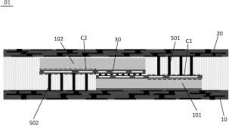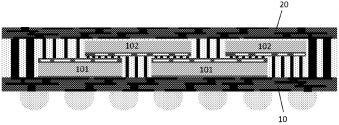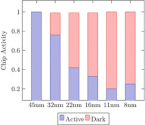SMIC is going to scale up the 7nm production.
You are using an out of date browser. It may not display this or other websites correctly.
You should upgrade or use an alternative browser.
You should upgrade or use an alternative browser.
Chinese semiconductor industry
- Thread starter Hendrik_2000
- Start date
- Status
- Not open for further replies.
The Chinese State for years tried to push Chinese companies towards investment in highly advanced semiconductor and IC chip manufacturing and the equipment to manufacture semiconductors and IC chips comprehensively. But Chinese companies were reticent into making that effort to anything close to the desirable extent, despite the subsidies and research and development assistance provided by the state. The attitude was geared towards maximizing profit making, and given that customers want the best quality goods and that China lagged much in almost every sector with regards to semiconductor and IC chips and the equipment to make them, progress was slow.I think it should have been obvious for years, that relying on western technology to create something powerful, to rely technology/economic growth using western tech, is not possible anymore.
Who has ambitions to advance to leading levels, to compete with world top players, must posses its own tech, a complete supply chain...
Creating AI more advanced than western, using western tech to achieve that... come on, thats not reasonable thinking.
Chinese companies truly believed that given China's enormous market that the United States wouldn't dare undertake curbs of supplies of advanced chips and advanced chip making equipment to them. They believed that the US government would follow the logic of economic profitability eternally. Trump coming to office and undertaking a trade war was a rude awakening, and has done much more than any policy proclamations and actual investments by the state to assist in R & D for Chinese companies to decide to get their act together. I have said for years that with regards to any item of technology that is worth producing and has value, China should have the domestic capability of producing it to high quality and should locate the ENTIRE domestic supply chain within China. The costs, however great they are, are much less than the value of having them when not having them subjects one to great vulnerability to any entity having ill-willed or hostile intentions as the United States has demonstrated in recent years and which it for decades actually telegraphed the intention of doing and becoming so to China.
In the last few days there been much talk, furor, and gloating (on the part of the China haters) of the decision by the US government to ban the supply to China by Nvida of the most advanced GPUs, and the US giving Nvdia a deadline to stop advanced GPU related research in China.
What are Chinese designed AND manufactured alternatives and how far behind technologically are such Chinese suppliers and manufacturers of GPUs from the likes of Nvdia?
What are Chinese designed AND manufactured alternatives and how far behind technologically are such Chinese suppliers and manufacturers of GPUs from the likes of Nvdia?
Can Chinese supercomputers do the same type and quality of work of the banned NVIDIA and ARM GPUs? I am asking for a friend...Yeah there wouldn't be much impact for Chinese supercomputer makers since they have their own fp64 accelerators. But it's going to have an impact on AI firms, particularly start-ups. Chinese supercomputers probably don't have the right AI libraries.
Chinese GPU makers are going to stay away from fp64 capabilities and focus on lower accuracy stuff, which would be fine for most AI but not physics simulations and scientific computation. Chinese supercomputer makers will focus on fp64 performance. I predict Nvidia will design a separate product line with fp64 capabilities disabled on its tensor cores and try to convince USG to let it sell those to China.
Can Chinese supercomputers do the same type and quality of work of the banned NVIDIA and ARM GPUs? I am asking for a friend...
That China still in 2022, after Trump's trade war and the telegraphing of advanced tech bans and restrictions for over a decade allowed NVDIA to have such a market share is telling...Enflame uses a 12nm technology, unknown foundry
Biren uses 7nm process from TSMC
Cambricon uses 7nm process from TSMC
Hanbo Semiconductor uses a 7nm technology, unknown foundry
All these new companies use 7nm or less advanced nodes. It is very wise for them not to use nodes below 7nm.
GPU specialized for AI are not smartphones, many less of them are needed, on the order of millions of chip, not billions. Final users are mainly big data centers and soon autonomous driving cars (but here big numbers are still few years down the road).
I give for granted that TSMC will also be banned from selling to these GPU firms (and I guess quite soon too), but if SMIC is able to scale their 7nm capacity to a decent number, then this last ban on NVIDIA will backfire hugely.
NVIDIA currently holds 90% of AI market in China!
It means a de-facto monopoly. Without banning on NVIDIA, it is easy to foresee that these new Chinese startup would have had a really hard time not only to grow, but even to survive. Now everything will be different.
This ban will at best slow down data centers build up, but US just gave away a totally dominating monopoly position in China in AI hardware.
I hope that Chinese companies had been working in the last few years to improve and have and build alternative capability and capacity...
Today's released products have been in the R&D pipeline for over 3 years already. So the timeline roughly matches my expectations.That China still in 2022, after Trump's trade war and the telegraphing of advanced tech bans and restrictions for over a decade allowed NVDIA to have such a market share is telling...
You can't just "replace" Nvidia with extremely subpar products. That would only lead to the (extremely important and valuable) downstream industries to lag behind their western competitors.
Not long ago, Huawei patented a flip chip packaging method that would implement wafer bonding of chiplets edge to edge. This would help resolve a lot of heat related problems you see with TSV connected 3D packaging and performance hits with 2.5D packaging. Basically, an intermediate solution between 2.5D and 3D packaging.Huawei has invested in packaging glue companies, I think the problem is related to 3d packaging

With 2 such wafer bonded chiplets, 2 redistribution layers would be needed to bond them, which means you could connect 4 chiplets in total.

If Huawei's upcoming "Return of the King" happens in 2023 as @ansy1968 has been stating, then I would "guess" that Huawei is in the middle of designing a 4 chiplet packaging scheme that splits SoC functionality into
- CPU
- GPU
- cache
- <everything else>

The power consumption issue would still remain but at least Huawei's chips would be relatively competitive again and they could also apply this to their other business divisions.
That China still in 2022, after Trump's trade war and the telegraphing of advanced tech bans and restrictions for over a decade allowed NVDIA to have such a market share is telling...
I think this is more a question of psychology and American soft power than China's technical capability. The level of stupid in China's corporate management has held China back because they refused to develop their own domestic R&D in the same manner as Huawei until the sh*t hit the fan => TRUMP. This mentality isn't simply about maximizing profits. You don't see this level of negligence in the face of American hostility for so long in other countries, especially so in countries like Russia. Fortunately, the sh*t did hit the fan and it is exactly what the doctor ordered. Companies like Lenovo, Xiaomi, and China's other such profit maximizing technology companies needed this wake up call. In the world we live in, no leading Chinese company should expect to ride the coat tails of American controlled core technologies if they expect to succeed.Today's released products have been in the R&D pipeline for over 3 years already. So the timeline roughly matches my expectations.
You can't just "replace" Nvidia with extremely subpar products. That would only lead to the (extremely important and valuable) downstream industries to lag behind their western competitors.
no, they are mass producing kunlun 2. Kunlun 3 is in development.so did you mean that Kunlun 3 is in mass production now?
At this point, I would say that BR100 is the most promising in terms of high end AI accelerator. The Cambricon one looks pretty good too.
Kunlun 2 is just useful because it is already in production and probably sold 10k unit already based on my calculation. It will be interesting to see if Tencent or Alibaba buy for Baidu. I kind of doubt it. But maybe if you are BYD and are building a data center for self driving, you'd be interested in Baidu chips.
The big 4 Chinese cloud/AI firms have been throwing a lot of money on building China's own AI chips, but it takes time to be put into production.That China still in 2022, after Trump's trade war and the telegraphing of advanced tech bans and restrictions for over a decade allowed NVDIA to have such a market share is telling...
I hope that Chinese companies had been working in the last few years to improve and have and build alternative capability and capacity...
until now, a lot of Chinese companies just didn't think US would do broad ban of something like GPU. As such, economics always driving corporations to purchase the most capable system at the lowest cost. Given Nvidia dominance in this space, it was natural to just build your data centers using their technology. Now that certain firms have been burnt, they might be more careful about that kind of stuff. Again, corporations are not loyal to the state for the most part. Their goals are just to survive brutal competition. For the most part, that helps a country's development. But that also makes it hard for gov't to push them to rely on domestic systems.
here is the thing though. US may stop selling stuff to China, but China will not do the vice versa. And as long as US politicians are on a sugar rush, they are not going to realize it when the cheap Chinese AI chips start to flood American market. But we are several years away from that. Amazon, Google and Microsoft are going to have no problem putting Chinese AI chips in their data centers as long as the performances are up to par. Nobody wants to keep overpaying Nvidia for monopolistic pricing.Eventually US will move to total decouple from China....but it will do this to defend itself from China, not to attack China. It will do it out of protectionism, to prevent Chinese firms to sell in US and western markets, like it did in photovoltaic and wind turbines.
Thanks for doing the numbers. My guess is that A100 is going higher than 5k per unit. Looking on e-bay, they are selling it for 9kI checked A100 GPU and it seems on average has a 30% markup on V100 solutions
"The A100 is being sold packaged in the DGX A100, a system with 8 A100s, a pair of 64-core AMD server chips, 1TB of RAM and 15TB of NVME storage, for a cool $200,000. For context, the DGX-1, a similar system with 8 V100s, cost around $150,000 at launch. That equates to a 33-percent generational price hike"
So let's assume 5K $ per unit.
NVIDIA officially stated that it expect to lose 400$ millions in third quarter due to A100 ban
So we are talking of about 80k chips per quarter, i.e. 300K-350K chips per year. This is the total market we are talking about and this is what SMIC should cover with its 7nm nodes.
Considering A100 has 64 chips per wafer
It means with perfect yield about 5500 wafer per year, with 50% yield about 10K wafer per year
Assuming 50% yield SMIC needs a capacity of 1K wpm (wafer per month) on 7nm to compensate for an eventual ban on TSMC.
on other places, I've seen anywhere from 10 to 15k. I did see the V100s were going for about 5k. So, it's possible, 400 million is probably more like 30 to 40k chips per quarter and 150k chips per year. But on top of that, Chinese firms will probably want to not buy other Nvidia/AMD GPUs also. I think the threat of a full AI accelerator chips is obvious. Any Chinese firms that don't realize that need to get their head smacked. So, I would think your estimate of 300 to 350k a year is a good estimate. This is also likely an industry that will keep growing pretty quickly. Maybe 500k in a couple of years -> 30k wafers per year using 25 to 30% yield.
30k wafer per year seems like a pretty easy to achieve. The new SMIC fab supposedly has capacity of 100k wafers per month. I guess AI chips is just a low volume, but high value type of chips. As such, I can see these big tech firms prioritizing AI chips to use domestic process ahead of say smartphone chips. Maybe that means Kunlun looking to design its Kunlun-2/3 chips with SMIC 7 nm+ process instead of Samsung. Same with Biren technology and Cambricon. I wouldn't be surprised if AI chips (Ascend 910?) is among the first chips that Huawei/Hisilicon produce with their all domestic line.
It's a good thing that both Samsung and TSMC can produce 5/7 nm chips. It will take longer to cut off Chinese chip design firms when there are 2 chipmakers fighting for their business in a market downturn. That should give SMIC/Hisilicon enough time to work with these chip design firms to get domestic process into mass production.
- Status
- Not open for further replies.
